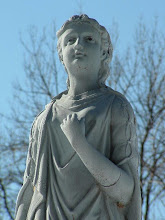
Aw, someone decorated this river-side tree with tin stars:

A squirrel must have tucked this walnut away for safekeeping:

The pond is freezing over but I'm going to hold off on putting out my ice-fishing hut just yet:

Garlic mustard waiting to be pulled out in the spring:

There wasn't much action today. I saw one rabbit, two cardinals and a chickadee. Here's a crappy shot of the male cardinal:

With a lot of the taller vegetation wasted away, some areas are more accessible than during the warmer months. (Just don't trip over the dog-strangling vine.) I wandered around to the back of the pond where I don't normally venture and discovered a nice Eastern wahoo. At least, that's what I think it is; if someone wants to correct me, I'll try to listen to reason:




Isn't that stunning?
Edit: Steve S and Native Plant Girl have set me straight: this is probably not the wonderfully named wahoo but an invasive relative, Euonymus alatus or Euonymus europaea. (Don't we get enough of invasive relatives at Christmas?) I'll keep an eye on this lovely shrub and decide what to do with it in the spring. Be sure to check out the comments on this post or visit Native Plant Girl's blog for more details. Many thanks to my intelligent readers who help me out!
I'll post again soon with a review of a couple of Beechwood-inspired gifts I received at Christmas. For now, I wish you all a happy, healthy new year!

8 comments:
Wahoo is an endangered species, extremely rare. The one you're seeing is Winged Euonymus, E. alatus, a problem invasive.
Happy New Year.
Thanks, Steve. How does one tell the difference?
Happy new year back at you from one of your readers :)
I love your blog and awesome pics!
The euonymus:
steve knows. :)
but, yeah, like you I was asking myself the same "how do I tell the difference?" question this fall.
The best ID advice I found was on page 123 of "Growing Trees from Seed A Practical Guide to Growing Native Trees, Vines and Shrubs" by Henry Kock with Paul Aird, John Ambrose and Gerald Waldron - http://www.fireflybooks.com/bookdetail&ean=9781554073634
In case you don't have the book, I'll quote it here for you:
“Two “ornamental” deciduous shrubs that are very common in the horticultural landscape have become naturalized (extensively in many places) in close proximity to older settlements and parks. Beside these two, garden escapees of the evergreen-leaved E. forunei are also beginning to find their way into the wild.
E. europaea, European spindle tree. The identification of this close relative of E. atropurpurea can only be made with certainty at flowering time. The European species has greenish white flowers in late May as compared to the maroon flowers (in June) of the native wahoo. The European spindle tree holds its leaves much longer into the fall, and the twigs tend to be thicker and more rigid than wahoo. However, due to variability in both species, the two are occasionally so similar vegetatively (including the root sprouting) that without knowledge of the flowers, the nearly identical fruit should be left alone – or the flower colour should be verified in late May.
E. alata, winged burning bush. A dense, outward-arching bush originating in Japan. It has small orange fruits on short stems that persist into the winter. Twigs on this species are prominently four winged, a characteristic that is more diminutive on a more compact growing-growing horticultural cultivar but still gives this species a distinctly square-stemmed appearance."
…in the end, that was enough info for me to make the ID, otherwise i was thinking about using flagging tape to mark the shrub and then going back May->June to look at the flowers to be sure.
Hi. Have a look at Native Plant Girls' latest blog. I've only ever seen the native at Guelph Arboretum, never in the wild.
Well technicalities aside, I loved your blogpost for the New Year, Marnie! complete with pictures.
Thank you!
Liz (boud)
Wow, a flurry of activity! I appreciate my loyal readers after a blogging hiatus. Thank you Steve for the ID and Native Plant Girl for expanding on it. I'm editing my post to add your information.
Hey Marnie,
Thank you so much for your blog. Visiting Beechwood with you through your blog was definitely one of the highlights of 2009 for me. Very best wishes to you for 2010.
Thank you very much, Anonymous!
Post a Comment